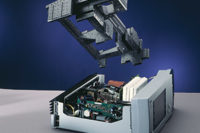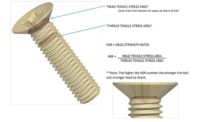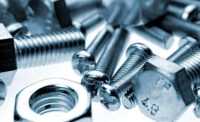Achieving limited success is often the result of making a poor decision at a critical moment. Few people in the history of North American manufacturing knew this better than P.L Robertson, the Canadian inventor of the Robertson square-drive screw and screwdriver.
In 1908, the year Robertson introduced his inventions, Ford Motor Co. introduced the Model T. Initially, the automobile was assembled using slotted-head screws. A couple years later, though, Henry Ford tried the Robertson screws and realized they saved nearly 2 hours in assembly time for each car because the square drive prevented the screwdriver from slipping out during installation.
Ford began using the screws in Model Ts made in Detroit. The Fisher Body company, which made car bodies for Ford, used more than 700 of the screws in its Model T made in Canada.
Within a short time, Ford attempted to get an exclusive license for the use and manufacture of the Robertson square-drive screw in the United States. When Robertson refused, Ford realized that the supply of screws would not be guaranteed. He decided to stop using them in the company’s U.S. plants and resumed using slotted-head screws. However, he allowed square-drive screws in Canadian-built Model Ts and Model As through the early 1930s.
“In 1933, Phillips cross-recess drive screws were introduced, and General Motors used them to assemble the 1937 Cadillac,” explains Michael L. Mowins, president of global licensing for Phillips Screw Co. “After that, the Phillips drive style became accepted throughout the auto industry, including by Ford. Robertson’s refusal to license his drive prevented its widespread adoption in the U.S., although it remains a very popular drive in Canada, especially for furniture assembly and boat building.”
Interestingly, the popularity of Phillips-drive fasteners in the U.S. auto industry has significantly waned since the late 1980s. Today, OEMs and Tier suppliers prefer fasteners with the TORX drive style because its design better prevents cam out (when the driver bit is forced back out of the screw recess under torsional load).
For many reasons—primarily the need to meet specifications—it usually takes several months or years of research and testing before an engineer selects a drive for fasteners used in a specific assembly application. With more internal and external drive styles available than ever before, today’s engineers are well-equipped to always select the best drive: The one that most effectively transfers torque from the drive tool to the fastener to achieve required clamp load.
It Started With a Slot
Drive styles have been around for several centuries. According to Mowins, the first screws with a drive were made of metal in Europe in the 1400s. They featured sawed-in slots across the full width of the head and were used to secure manacles and leg irons in place. In the 16th century, European clock makers and other craftsmen began using slotted screws.
Some 250 years later, Job and William Wyatt from Staffordshire in the English Midlands patented a method to mass produce cut-thread screws with countersunk slotted heads. The slot was milled rather than formed with a saw.
Further advances in screwmaking have included automating the process of forming slots in screw heads using a punch press. Even though slotted-drive screws remain the simplest and cheapest to make, they are never used in automated assembly due to the likelihood of a power tool or bit slipping out of and damaging the screw head or product being assembled. Manufacturers prefer using these screws in very-low-volume manual assembly applications such as woodworking.
A variation of the slotted drive is the cross drive, which features two slots perpendicular to each other formed into a wide, thick and hard screw head. This drive accepts any standard slotted screwdriver, generates higher torque than a single slot and provides redundancy for assemblers. Should the top, bottom or all of one slot become deformed during installation, the top, bottom or all of the other slot may still be used.
The Crucial Cruciform
Aware of the high torque generated by the cross drive, engineer John Thompson looked to improve on this design in the 1930s so a screwdriver wouldn’t constantly slip out of the end of the slot. His design featured a perfect four-pointed star that tapered to a very sharp point in the middle. Equally important, the four wings extended partially (rather than fully) across the screw head, and each wing featured angled walls to keep the screwdriver engaged.
Thompson liked his design but had no luck selling it to a screw manufacturer. Instead, he sold it to fellow engineer Henry Phillips, who then tweaked the design into the now-famous Phillips drive. Phillips’s main change was making the recess shallower to strengthen the screw head. His angled recess wall redesign ensured auto-centering of the screwdriver so that it cams out of the drive recess only after the screw is fully seated.
Unlike Robertson, Phillips successfully licensed the manufacture of his screws to many screw companies. By 1940, according to Mowins, 85 percent of American screw companies had licenses for the design.
Hoping to imitate the success of the Philips design, various inventors and companies brought other cruciform-type drives to market. In the late 1930s, the Reed & Prince Manufacturing Co. of Worcester, MA, began making the Frearson-drive screw, which was developed by British inventor John Frearson several decades before.
The Frearson drive features a perfect sharp cross, which allows for higher applied torque than the Phillips. It also has a sharper tip and larger angle (75 degrees) in the V-shape recess. In addition, one driver bit fits all screw sizes. Frearson-drive screws are most often used to assemble marine hardware.
In the 1950s, Phillips Screw Co. introduced Torq-Set, an offset cruciform drive system that remains a standard drive on screws used in many of the world’s commercial and military aircraft. The Torq-Set drive features four cross arms that are offset from each other and do not form intersecting slots across the top of the head. It requires a specialty screwdriver or bit for installation. A ribbed version of the screw, called ACR (anti-cam-out recess) Torq-Set, has been available since the 1990s.
The Tri-Wing drive—also developed in the 1950s—is the tamper-resistant version of Torq-Set and features three slotted wings and a small triangular hole in the center. In recent decades, manufacturers of consumer devices have begun using Tri-Wing-drive screws to protect sensitive electronics or prevent consumer shock injuries as a result of tampering.
Phillips (in partnership with licensees) developed its second cruciform drive, called Pozidriv, in 1966. Mowins says this drive is specifically designed to ensure more positive tool engagement, resulting in less cam out and the application of higher torque.
Unique design features of the drive include negatively drafted driving walls in the recess and on the screwdriver wings, along with notches in the center of the recess to better position the screwdriver. Because the Pozidriv and Phillips look so similar, assemblers may use an incorrect screw unintentionally during assembly. Phillips screwdrivers can install Pozidriv screws, but not vice versa. To help assemblers quickly distinguish between the drives, Pozidriv has a starburst head mark.
Mowins says that Pozidriv quickly gained popularity in Europe and became the standard for most tapping screws. Its acceptance as the metric cruciform drive system carried over to the U.S. where the automotive and electrical industries still use it as an easy way to identify which screws have inch-based or metric threads.
Supadriv was developed by Guest Keen & Nettlefolds, Phillips’ British licensee of Pozidriv in Europe, in the late 1970s. Although similar to Pozidriv, the new drive has an angular 2.5-degree mismatch between the outer wall angle of the driver and the inner wall angle of the recess. This design allows the driver to rock in the recess. It also allows a small angular offset between the screw and screwdriver during installation.
Phillips next drive design focused specifically on the problem of cam out. Introduced in the early 1980s, the ACR Phillips features ribs in the recess that interlock with raised ribs on the mating driver bit. It was first used in aerospace applications to gain higher torque levels.
The success of this drive led to the development of the ACR Phillips II driver, which came out in 2002. Rather than ribs, the Phillips II features anti-cam out pads in the recess wall that interlock with higher-strength, slanted and tapered ribs on the mating bit.
Other Internal Types
Non-cruciform drives have been present in manufacturing since the Robertson square head first appeared at the start of the 20th century. The ones most often used in U.S. assembly applications are the hex (external and internal), TORX and Mortorq.
The external hex drive refers to any fastener head with a hexagonal, six-sided shape. Such screws and bolts have been around since the late 19th century. Their main benefit is the hexagonal shape allows an assembler to rotate the fastener with small wrench-swing arcs when surrounding obstacles limit access.
The internal hex drive was patented in 1909 by W.G. Allen. Screws with this drive are known as socket cap screws and installed with an Allen key (low-volume applications), or a hex screwdriver or bit (moderate to high volumes).
The problem of hex keys slipping in hex drives prompted Camcar Textron (now Acument Global Technologies) to develop the TORX drive in 1966. It has a star-shaped recess with six rounded lobes. Dave Goss, principal engineer for Acument, says the design offers high torque transfer, resistance to cam out and bit wear life. It also reduces operator fatigue by minimizing the need to press down hard on the driver during assembly.
TORX has been very popular in the automotive industry for several decades and is becoming widely used in many other industries, including consumer electronics. TORX PLUS, introduced in 1990, offers a larger cross section at the lobes and a true zero-degree drive angle to eliminate radial forces.
In 2002, Acument developed the TORX PLUS MAXX drive system for studs. Lobes on the external drive extend into the threaded portion of the fastener and fully engage the drive socket. This allows much higher installation torque capability. Jim Wayman, licensing marketing and regional manager for Acument, says the company will introduce a new drive in 2016 called TORX Paralobe.
Phillips created the six-lobe HexStix drive in 2008 to compete against TORX. A HexStix screw is designed to stay engaged on the bit even if it’s rotated 360 degrees prior to installation. After the screw is fully seated, the bit disengages easily.
The Mortorq drive series consists of the Mortorq spiral drive (2002), Mortorq Super enhanced spiral drive (2007) and External Mortorq Super for bolts (2013). Mortorq and Mortorq Super drives feature four curved, triangular wings spread from a center point. This shape provides full contact of the driver bit. The External Mortorq Super drive features a six-curved-star.
Mortorq was developed to provide aerospace manufacturers a drive head that ensured removal of all screws (intact and damaged) during plane repairs and overhauls. Mowins says that none of the screws manufacturers were using had drive heads strong enough to handle the extra torque needed to remove damaged screws or those stuck in place due to wear.
“Because the Mortorq drive doesn’t generate a radar pattern, it’s been used on the Stealth bomber (B-2 Spirit) for several years now,” notes Joe Greenslade, director of engineering technology for the Industrial Fastener Institute. “All fasteners with TORX, Tri-Wing and standard Phillips drives were spotted by radar.”
Selection Limitations
Fastener suppliers and drive-design companies acknowledge that more than 20 drive styles are in use to some degree by U.S. manufacturers. Practically speaking, however, design engineers usually have very few drive options for any one application due to four factors: specification, tradition, automation and commonization.
Drive specifications can range from very specific to somewhat generic, depending partly on the standards organization and partly on the application. For example, one standard may only allow Pozidriv (Type 1A) screws, while another standard may allow any Type 1A cruciform screw. This latter standard accepts Pozidriv screws from Phillips-licensed suppliers, as well as screws from unlicensed suppliers that may not be exactly the same as Pozidriv, but still meet drive design parameters.
Manufacturers in many industries often specify the generic category of hexalobular (six-lobe) drive screws, rather than specifically requiring any TORX or HexStix drive. The generic approach can result in big cost savings when large amounts of fasteners are used, but it comes with the risk of inconsistent or poorer quality.
Tradition tends to be the deciding factor under two circumstances: the current drive style is performing excellently, or there isn’t the time or money available to research and test all available drive options. In these cases, the engineer simply defaults to the same drive style the company has used for the last several months or years, notes Gene Simpson, vice president of quality and engineering for Semblex Corp. He says this practice is very common among automotive and white goods manufacturers.
“Because white goods manufacturers deal with such high volumes and are so cost driven, they like to stick with fasteners having just a few traditional drive styles,” explains Simpson. “The most common are the standard cross recess designs, the basic square and the external hex.”
However, when the project deadline and budget allow some flexibility, suppliers say it’s wise for the engineer to thoroughly research the latest capabilities of all spec-allowed drives, as well as the different materials used in the application. Sometimes, changing drives and making minor alterations to one or more materials can improve assembly speed and product quality.
Goss recalls an incident where assemblers at the plant of one customer stood and applauded when the line manager showed up for work. They clapped in appreciation of the manager convincing the company to change from cruciform-drive screws to TORX. The change increased productivity, lessened noise and improved worker ergonomics.
Regarding automation, some suppliers say that a straight-wall recess drive (such as TORX) is better than the hex for very high torque applications because the hex drive may wedge in the socket or bit. Others say that any self-centering drive will work just fine in these applications.
For standard screws installed with moderate torque, hex and square (Robertson) drives are recommended over the standard cruciform (Phillips) drive because they require less axial effort to maintain bit engagement. However, suppliers say the standard cruciform is best for small screws, and the interlocking cruciform (like ACR Phillips) is best for tiny screws with very low torque.
A final selection factor is what Mike Herdman, director of engineering for Shamrock International Fasteners, calls commonization. This is the practice of only selecting common drives or those that accept multiple types of common screwdrivers or bits used by assemblers. Besides simplifying driver and bit monitoring, this approach also limits the amount of time assemblers spend switching tools and the likelihood of them using the wrong tool.
“This approach has really benefitted our automotive, white goods and lawn and garden customers,” says Herdman. “Some often end up using just two or three common drives like the external hex and six-lobe. Others only need a combination drive, such as a cruciform with square recess.”







